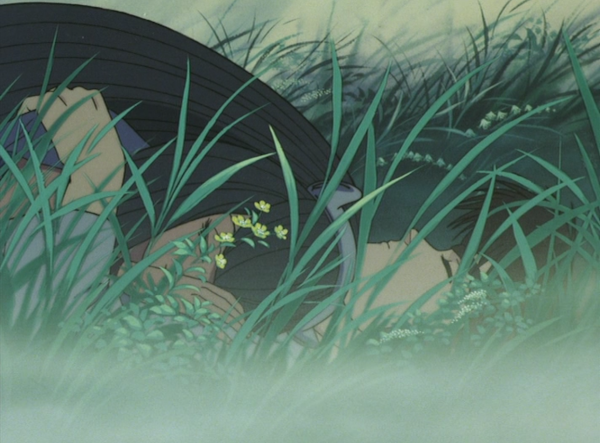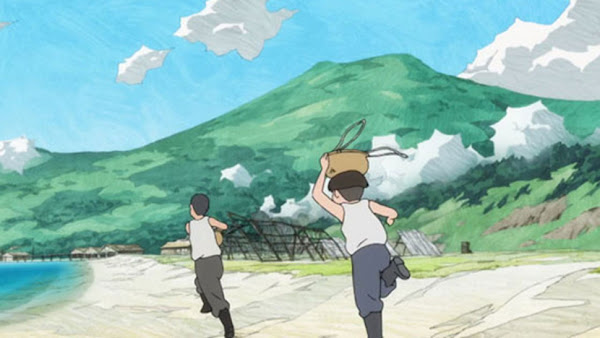Classic tragœdy, modern politics in Phœnix: Yamato Chapter
The second entry in the OVA Phœnix series, the Yamato chapter, unfolds with the kind of clockwork certainty of Le Morte de Arthur, but with a uniquely Japanese (I should say, uniquely Tezuka) twist. The tale of a doomed love between a prince of Yamato named Oguna, and a noblewoman Kajika of the dissident clan of Kumaso – the Yamato chapter explores questions of love versus honour, the value of human life and the nature of sacrifice. Although Tezuka, and Rintarô along with him, approach this period of Japanese history with the sceptical eye that folks of the postwar generation tended to reserve for the nationalist mythos of the Imperialists, they do not entirely discount it. There is indeed something to be said for the tragic heroism of the main characters and the selflessness with which they face their own deaths… even as they sacrifice themselves willingly to make a strong point against the cultus of political violence and disdain for life represented by Oguna’s elder brothers.
In short, the story follows Oguna as he proceeds in disguise to the lands of Kumaso, having been tasked with his father with upholding the family honour by murdering the clan chief of Kumaso, named Takeru. However, his life is saved by Takeru’s strong-willed sister Kajika, who quickly comes to understand that he is not (as he purports to be) a travelling merchant, but someone of much more noble stock. Despite knowing this, Kajika falls in love with him anyway. However, the love between them takes on a certain tragic significance as Kajika comes to a full awareness of Oguna’s mission. Torn between love and duty, Oguna begins playing on his flute, drawing the attention of the mythical bird of fire who lives in the Kumaso lands. The bird pities Oguna, but cannot undo the fate that he has woven for himself, being a kind-hearted boy in the midst of several cold-hearted plots involving his own kin and honour.
Like the other entries in the Phœnix series, Yamato chapter is brilliant because it works on so many different levels. In the beginning, the tale of Oguna and Kajika is a tragic chivalric romance that is pretty much played straight. But it soon subverts its own premise when, after Oguna returns to Yamato, Oguna’s brothers cruelly reveal the actual, self-centred intentions of their father in giving the order. Then it becomes clear that Tezuka, far from romanticising or idolising this era in Japan’s past, is ruthlessly tearing away the veil over its code of chivalric honour, and showing it up as the plaything of a cruel, callous and predatory ruling caste which has no regard whatsoever for human life. It then falls upon Oguna’s shoulders to resist his brothers and attempt to save the people they have condemned to be buried alive, to accompany their father to the afterlife.
Remember, though, that for Tezuka – and this applies across the Phœnix-verse – the past is never ‘just’ the past. Implicit in his treatment of feudal Japan is a critique of a more modern Japan. The live-burial treatment visited upon Yamato’s prisoners appears to be deliberately reflective of its behaviour in a more recent war. A Japan which sacrifices victims (particularly women and children) to sate its own sense of honour and to memorialise its fathers, is not confined in Tezuka’s understanding to its distant past! Indeed, the title card at the end declaring the end of human sacrifice after Oguna’s death, serves as much to turn the lens back on and hang a big fat question mark over the present, as it does to bookend this ‘historical’ tragœdy.
Speaking to the story, though: both Oguna and Kajika are both instantly-relatable, charismatic and sympathetic leads, even though Oguna is morally compromised essentially from the very start. Their love affair is allowed to unfold realistically and with all the appropriate drama, though Kajika’s brother Takeru ultimately suffers from a naïveté which strains credulity. The actions of the Phœnix in this story, on the other hand, are much more inscrutable. Indeed, her actions show her to be powerless in the face of the insane, cruel violence that the characters inflict upon each other… up until the very end. Thus, although we are moved to sympathy by Oguna’s and Kajika’s plight, we are left wondering if it was really needful, if it wasn’t all just a waste. But—the wastefulness and cruelty of Japan’s militaristic and feudal past is precisely what Tezuka is trying to get us to see, and recoil from.
That sort of showcases the weakness of Yamato chapter, which is its loose storytelling. Whereas in Karma chapter there is not one single look or gesture or action that does not in some measure ‘pay off’ by the end, here there are a lot of frayed ends and unanswered questions. For inspiration for this story, Tezuka was clearly drawing upon not only the Yamato Takeru legend and the Matter of Britain, but also upon the traditional Chinese legend of Liang Shanbo and Zhu Yingtai and Shakespeare’s Romeo and Juliet: both of which deal similarly with the competing demands of love and duty, of humaneness versus obedience, as the basis for the tragœdy which unfolds. Indeed, a lot of the actions of the main characters must be attributed, in some measure, either to the demands of honour or to the irrational selflessness of love – whether fraternal or romantic. There is little other way to express or explain the self-sacrificial actions of all three of the main characters: Takeru, Oguna and Kajika. But the fact that these actions do go unexplained, and indeed seem somewhat arbitrary, rather dulls the emotional impact of the ending, which feels a tad more anticlimactic than cathartic.
Still, the artwork and the music are both – as to be expected from 80s Madhouse – charmingly done, and the character designs and set pieces are more than unique and colourful enough to offset the weak points of the plot toward the end. I found particularly interesting the palette, architectural and sartorial choices on the part of the director – which may indeed go back to Tezuka’s original artwork – that differentiate the (fiery, passionate, ‘primitive’, black-and-red) culture of Kumaso from the (reserved, stately, decorous yet emotionally-remote, grey-and-white) culture of Yamato. These choices serve to better foreground the choice standing before Oguna and – later – Kajika of where to belong and what to commit to.
Would I still recommend this chapter to viewers, though? Absolutely. Despite not quite attaining the formidable storytelling heights of Karma Chapter, Yamato Chapter manages to be stirring, hauntingly-beautiful and thought-provoking, with a touching central love story and a story of revenge and forgiveness that transcends sin and death.







Hi, Matthew. Congrats for the blog. Please have a look at the new episode of Blue Angel Series. Also experimenting new formats, as a book and a graphic novel. Would love to see your feedback. Regards.
ReplyDeletehttps://www.blueangelseries.com
Hi Claudio! Excellent; I have been looking forward to a new installation in your series, and I will absolutely come around to have a look at it. Thanks for reading, as well!
Delete